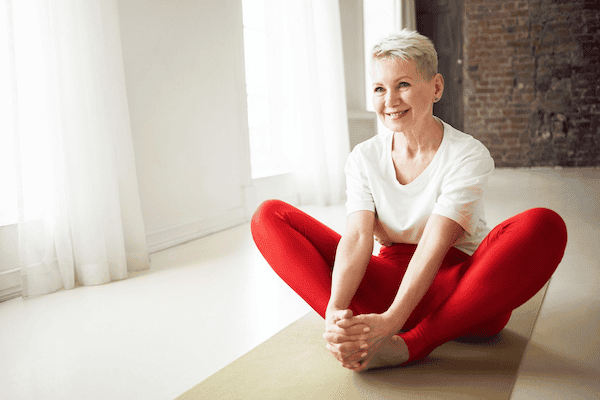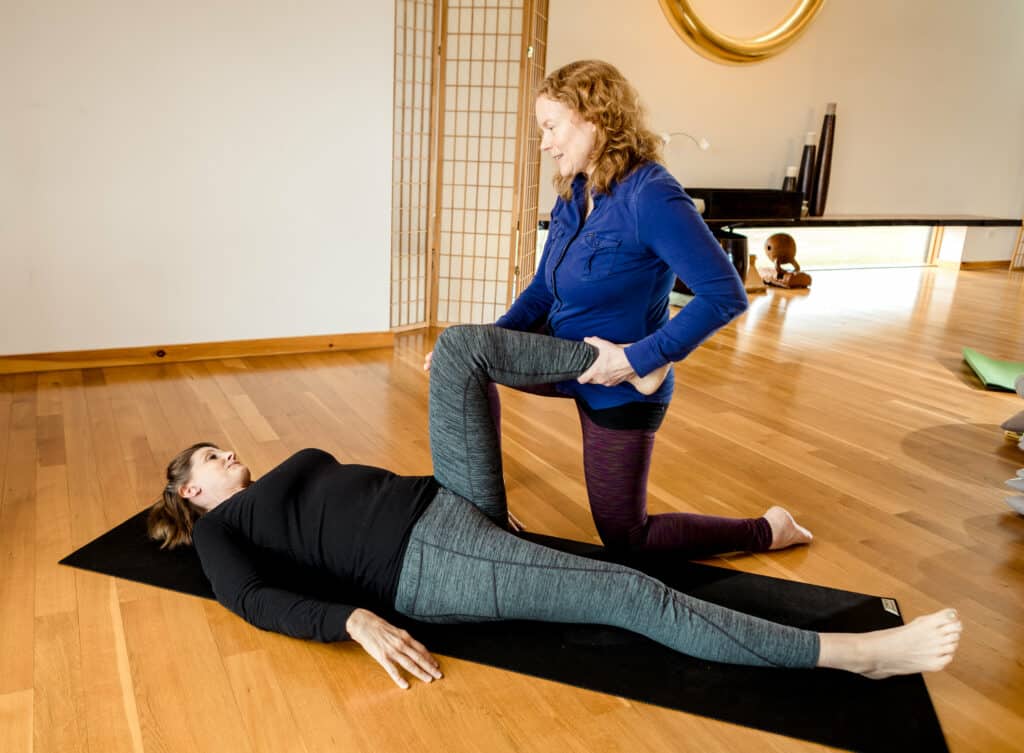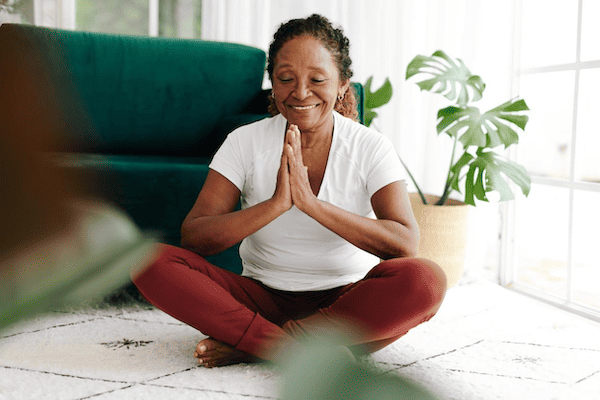
Many people facing hot flashes from menopause find that traditional Western medicine still falls short of providing them with adequate relief. More and more patients as well as providers are turning to yoga for menopause hot flashes. Yoga provides not only a variety of different techniques you can try, but also frameworks to apply those techniques in an individualized, therapeutic way. The result is that it can be easier to manage hot flashes and find peace from these symptoms.
I’m Brandt Passalacqua, an experienced yoga therapist and the Co-Founder, Director, and Lead Teacher of Breathing Deeply, a yoga therapy training program. I’ve worked with clients who are experiencing menopause, and I’ve also had the great privilege of teaching a student, Fiona Jalinoos, who successfully treated a small group of women with menopause using yoga therapy. I’m here to share my knowledge and experience, as well as what I’ve learned from Fiona’s work, to help more people find relief.
Table of Contents:
The first step to treating menopausal symptoms is to understand them. Not only is it important to understand how hot flashes present, but also how they may affect you.
For anyone who has had a hot flash before, it needs no introduction. The intense, uninvited wave of heat may be accompanied by rapid heartbeat, flushed skin, and even sometimes a cold shiver. Hot flashes can last anywhere from a few seconds to an hour, though most are around 30 seconds to 5 minutes. Their frequency, duration, and symptoms can vary from person to person.
More than just a physical discomfort, hot flashes can be a major disruption to your daily life. Unpredictable, they can interfere with your work, sleep, and social life. They can negatively impact your mood and concentration, both during and after the episode.
In addition to their physical toll, many people develop anxiety around having hot flashes, which can be just as harmful. According to a study in the Journal of Women’s Health, menopausal symptoms like hot flashes can negatively impact quality of life, and there is a significant need to find better ways of managing these symptoms.

Menopause can introduce a whole host of hormonal changes and unpredictability to your life. Yoga offers you a way to move toward physical, mental, emotional, and spiritual balance. It helps you develop greater emotional resilience. As you practice movements and breathing techniques, you can become more in-tune with your body’s needs.
Yoga teaches us how to accept change and sit with discomfort, working with your body instead of fighting against it. During this major life transition, you can gain self-understanding, acceptance, and inner peace.
Yoga encompasses a wide variety of techniques. These include:
When it comes to yoga therapy, these techniques are personalized to you, not just your symptoms.
In Western medicine, treatment usually boils down to prescribing the same interventions to anyone facing a particular condition, adjusting for any contraindications. Yoga therapy allows us to use an Ayurvedic framework when applying techniques.
What this means is that the techniques recommended to you by a yoga therapist take into account your unique body, mind, history, imbalances, limitations, and goals. Your treatment is tailored to you in a way that Western approaches tend to miss, making yoga a valuable addition to your medical care.

Movement is an important component in yoga therapy. The exact yoga poses for menopause hot flashes that will work best for you may not be the ones that work for someone else. This is why it’s so critical to work one-on-one with a yoga therapist when seeking relief.
With that in mind, there are certain yoga poses that are more likely to be beneficial when hot flashes hit. Consider these examples:
In general, I recommend gentle asanas that focus on stretching and relaxation, rather than more intense, challenging poses that will make you feel more overheated and overexerted.
Breathing exercises can be especially helpful for reducing anxiety, releasing tension, and relaxing. The evidence is mixed when it comes to exactly how helpful these techniques are for relieving symptoms in the moment. But pranayama can help you build resilience and give you tools for dealing with discomfort more effectively.
For example:
For best results in combating anxiety, I usually recommend syncing breath and movement, as well as extending exhales. These techniques can often come into play when using yoga for menopause hot flashes.
Meditation allows you to observe and acknowledge the sensations of hot flashes without judgment. It helps you put your discomfort into perspective, feel less apprehensive, and achieve greater peace and acceptance.
By meditating regularly, you can regain a sense of control over your life as hot flashes lessen their grip over you. Meditating for even just 10 minutes a day has been shown to facilitate changes in the brain that lessen our reactivity.
It can take practice and professional guidance to learn how to meditate successfully. Tips include:
As with any new physical exercise, it’s important to make sure you’re practicing yoga safely. That involves understanding your own needs and limitations, as well as knowing how menopause might affect you and the common contraindications to avoid.
Listen to your body and consult with a doctor if needed. By practicing under the guidance of a yoga therapist, you can make sure your yoga practice is tailored to your unique circumstances so it is safe, practical, and effective.
Before you roll out your yoga mat and start practicing, it’s vital to have a clear picture of your health. You need to understand your body’s limitations and whether any other health conditions you may have could affect your yoga practice. Ask yourself, among other things:
By assessing your current health condition, you can make sure your yoga practice helps to relieve the symptoms of menopause, rather than exacerbate or interact poorly with them or other aspects of your health.

Group yoga classes usually work best if you’re interested in using yoga for exercise and practicing yoga in a social setting. If you want to use yoga techniques to address specific health conditions or symptoms, such as hot flashes, you’re better off working one-on-one with a yoga therapist. This ensures that your yoga practice is tailored to your individual needs.
Yoga therapists are trained to apply yoga techniques therapeutically to treat specific health conditions. We can tailor poses, breathing techniques, and meditation practices to your body’s unique responses to menopause. A personalized, therapeutic approach to yoga will offer you the most relief and holistic wellness.
Yoga is not a one-size-fits-all approach. It can easily be modified to make sure you are comfortable and safe, as well as bring more challenging poses within reach. Consider these tips:
If you work yourself too hard, you could make your symptoms worse or even injure yourself. With hot flashes in particular, you’re already feeling overheated, so it’s important not to overexert yourself. This can include:
Avoid hot yoga, which is practiced in a heated environment, and more rigorous styles of yoga.

Staying hydrated is important, both when practicing yoga and when experiencing hot flashes. Water can help to regulate your temperature. By adequately hydrating, you also ensure that your muscles and joints are well-lubricated and your body receives the nutrients it needs to function effectively.
Keep track of your water intake before, during, and after yoga. Water bottles with measurements printed on them can help make this easier. Just be careful not to overdo it with the water either. Drinking too much water while practicing yoga can sometimes cause nausea.
If you practice yoga techniques, especially under the supervision of a yoga therapist, what outcomes can you expect? For anyone considering using yoga for menopause hot flashes, this is sure to be on your mind. Outcomes will vary from person to person, but these are the main outcomes I’ve observed.
Getting hot flashes can cause people to become anxious, worried about when they’ll happen next. Studies indicate that yoga can reduce stress, anxiety, and depression. It can help you to regulate your nervous system responses, shifting from fight-or-flight mode to a rest-and-digest state. This can help you reduce feelings of pain, suffering, and mental anguish after a hot flash, making it one of the biggest benefits that yoga can provide.
Hot flashes are one of the most challenging menopause symptoms to manage. In most cases, people are not easily rid of them. With time and interventions such as hormone therapy, medication, and lifestyle changes, you can relieve your symptoms and better learn how to deal with having hot flashes. Yoga gives you another tool you can use to manage your hot flashes throughout the stages of perimenopause and menopause.
Hot flashes can disrupt your sleep and make it difficult to fall back asleep. Over time, this can become a major problem and have a negative impact on your quality of life. Studies have shown that yoga can improve sleep quality for the elderly and for those experiencing insomnia. Anecdotally, Fiona and I have seen yoga help people with hot flashes to get better sleep and fall back asleep more easily when it’s disturbed.

Yoga is as much a mental practice as it is a physical one, teaching us to accept what we cannot change. As you move through the transition into menopause, embracing your body’s changes can be empowering. Yoga helps to foster the connection between your mind and body, encouraging understanding and patience.
Through sustained practice, you may notice a shift in perspective, accepting where you are in this journey and feeling better about being menopausal. Even when you experience discomfort, you will be better equipped to accept it, manage it, and live with it. With this acceptance comes inner peace and a deeper connection with yourself during this new phase in your life.
While hormone therapy and other medical interventions play their roles, yoga can be an incredible complement or support to traditional care during menopause.

Ready to try using yoga for menopause hot flashes? We want to make sure you’re practicing yoga safely and effectively. Learn about our private sessions, which are conducted online one-on-one with one of our experienced yoga therapists.
Brandt talks about common questions applicants have about the Breathing Deeply Yoga Therapy Program. Tune in to get the full program details.
Friends in Yoga, The way we perceive the world is a curious thing. Is it on fire or getting better? Are we facing our challenges or shying away from them? Are we functioning from the present or some altered reality based on past experiences? The teachings tell us that reality is ultimately timeless. The vibration […]
There’s no doubt that yoga is gaining popularity, but you may be asking yourself, what is the most popular type of yoga? Where is each type most popular in the U.S. and around the world? And for those who are interested in trying it themselves, how can you practice these styles of yoga safely? For […]
Friends in Yoga, Sitting on a cushion, taking a yoga class, chanting a mantra before your morning coffee…no one would call these radical acts. They are small choices that we make to better ourselves. The motivation to practice often takes form by our desire to be healthier, to be more focused, to connect with our […]